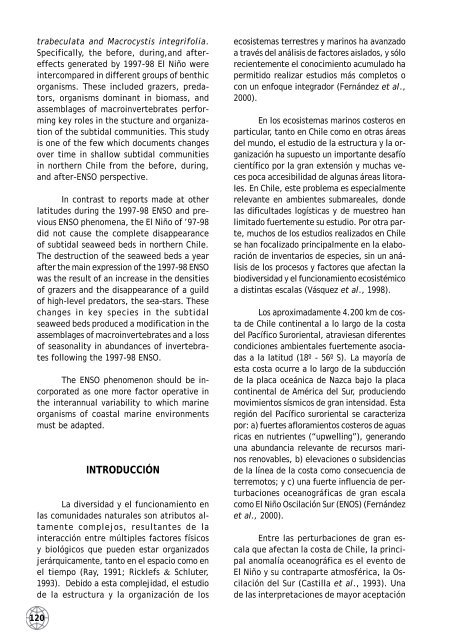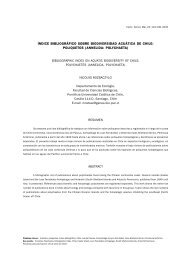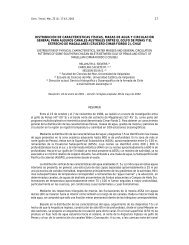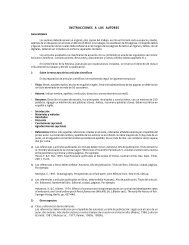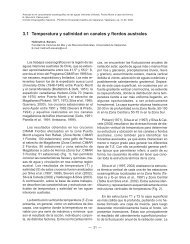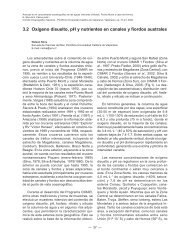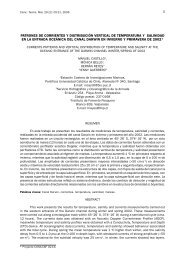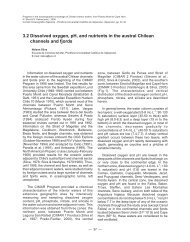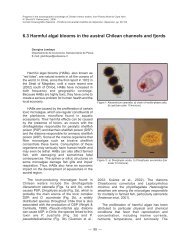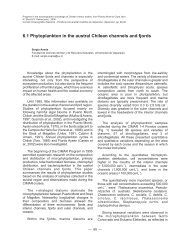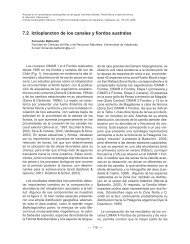El Niño 1997-98 en el norte de Chile: efectos en la estructura y en la
El Niño 1997-98 en el norte de Chile: efectos en la estructura y en la
El Niño 1997-98 en el norte de Chile: efectos en la estructura y en la
Create successful ePaper yourself
Turn your PDF publications into a flip-book with our unique Google optimized e-Paper software.
trabecu<strong>la</strong>ta and Macrocystis integrifolia.<br />
Specifically, the before, during,and aftereffects<br />
g<strong>en</strong>erated by <strong>1997</strong>-<strong>98</strong> <strong>El</strong> Niño were<br />
intercompared in differ<strong>en</strong>t groups of b<strong>en</strong>thic<br />
organisms. These inclu<strong>de</strong>d grazers, predators,<br />
organisms dominant in biomass, and<br />
assemb<strong>la</strong>ges of macroinvertebrates performing<br />
key roles in the stucture and organization<br />
of the subtidal communities. This study<br />
is one of the few which docum<strong>en</strong>ts changes<br />
over time in shallow subtidal communities<br />
in northern <strong>Chile</strong> from the before, during,<br />
and after-ENSO perspective.<br />
In contrast to reports ma<strong>de</strong> at other<br />
<strong>la</strong>titu<strong>de</strong>s during the <strong>1997</strong>-<strong>98</strong> ENSO and previous<br />
ENSO ph<strong>en</strong>om<strong>en</strong>a, the <strong>El</strong> Niño of ’97-<strong>98</strong><br />
did not cause the complete disappearance<br />
of subtidal seaweed beds in northern <strong>Chile</strong>.<br />
The <strong>de</strong>struction of the seaweed beds a year<br />
after the main expression of the <strong>1997</strong>-<strong>98</strong> ENSO<br />
was the result of an increase in the d<strong>en</strong>sities<br />
of grazers and the disappearance of a guild<br />
of high-lev<strong>el</strong> predators, the sea-stars. These<br />
changes in key species in the subtidal<br />
seaweed beds produced a modification in the<br />
assemb<strong>la</strong>ges of macroinvertebrates and a loss<br />
of seasonality in abundances of invertebrates<br />
following the <strong>1997</strong>-<strong>98</strong> ENSO.<br />
The ENSO ph<strong>en</strong>om<strong>en</strong>on should be incorporated<br />
as one more factor operative in<br />
the interannual variability to which marine<br />
organisms of coastal marine <strong>en</strong>vironm<strong>en</strong>ts<br />
must be adapted.<br />
INTRODUCCIÓN<br />
La diversidad y <strong>el</strong> funcionami<strong>en</strong>to <strong>en</strong><br />
<strong>la</strong>s comunida<strong>de</strong>s naturales son atributos altam<strong>en</strong>te<br />
complejos, resultantes <strong>de</strong> <strong>la</strong><br />
interacción <strong>en</strong>tre múltiples factores físicos<br />
y biológicos que pued<strong>en</strong> estar organizados<br />
jerárquicam<strong>en</strong>te, tanto <strong>en</strong> <strong>el</strong> espacio como <strong>en</strong><br />
<strong>el</strong> tiempo (Ray, 1991; Ricklefs & Schluter,<br />
1993). Debido a esta complejidad, <strong>el</strong> estudio<br />
<strong>de</strong> <strong>la</strong> <strong>estructura</strong> y <strong>la</strong> organización <strong>de</strong> los<br />
ecosistemas terrestres y marinos ha avanzado<br />
a través d<strong>el</strong> análisis <strong>de</strong> factores ais<strong>la</strong>dos, y sólo<br />
reci<strong>en</strong>tem<strong>en</strong>te <strong>el</strong> conocimi<strong>en</strong>to acumu<strong>la</strong>do ha<br />
permitido realizar estudios más completos o<br />
con un <strong>en</strong>foque integrador (Fernán<strong>de</strong>z et al.,<br />
2000).<br />
En los ecosistemas marinos costeros <strong>en</strong><br />
particu<strong>la</strong>r, tanto <strong>en</strong> <strong>Chile</strong> como <strong>en</strong> otras áreas<br />
d<strong>el</strong> mundo, <strong>el</strong> estudio <strong>de</strong> <strong>la</strong> <strong>estructura</strong> y <strong>la</strong> organización<br />
ha supuesto un importante <strong>de</strong>safío<br />
ci<strong>en</strong>tífico por <strong>la</strong> gran ext<strong>en</strong>sión y muchas veces<br />
poca accesibilidad <strong>de</strong> algunas áreas litorales.<br />
En <strong>Chile</strong>, este problema es especialm<strong>en</strong>te<br />
r<strong>el</strong>evante <strong>en</strong> ambi<strong>en</strong>tes submareales, don<strong>de</strong><br />
<strong>la</strong>s dificulta<strong>de</strong>s logísticas y <strong>de</strong> muestreo han<br />
limitado fuertem<strong>en</strong>te su estudio. Por otra parte,<br />
muchos <strong>de</strong> los estudios realizados <strong>en</strong> <strong>Chile</strong><br />
se han focalizado principalm<strong>en</strong>te <strong>en</strong> <strong>la</strong> <strong>el</strong>aboración<br />
<strong>de</strong> inv<strong>en</strong>tarios <strong>de</strong> especies, sin un análisis<br />
<strong>de</strong> los procesos y factores que afectan <strong>la</strong><br />
biodiversidad y <strong>el</strong> funcionami<strong>en</strong>to ecosistémico<br />
a distintas esca<strong>la</strong>s (Vásquez et al., 19<strong>98</strong>).<br />
Los aproximadam<strong>en</strong>te 4.200 km <strong>de</strong> costa<br />
<strong>de</strong> <strong>Chile</strong> contin<strong>en</strong>tal a lo <strong>la</strong>rgo <strong>de</strong> <strong>la</strong> costa<br />
d<strong>el</strong> Pacífico Surori<strong>en</strong>tal, atraviesan difer<strong>en</strong>tes<br />
condiciones ambi<strong>en</strong>tales fuertem<strong>en</strong>te asociadas<br />
a <strong>la</strong> <strong>la</strong>titud (18º - 56º S). La mayoría <strong>de</strong><br />
esta costa ocurre a lo <strong>la</strong>rgo <strong>de</strong> <strong>la</strong> subducción<br />
<strong>de</strong> <strong>la</strong> p<strong>la</strong>ca oceánica <strong>de</strong> Nazca bajo <strong>la</strong> p<strong>la</strong>ca<br />
contin<strong>en</strong>tal <strong>de</strong> América d<strong>el</strong> Sur, produci<strong>en</strong>do<br />
movimi<strong>en</strong>tos sísmicos <strong>de</strong> gran int<strong>en</strong>sidad. Esta<br />
región d<strong>el</strong> Pacífico surori<strong>en</strong>tal se caracteriza<br />
por: a) fuertes aflorami<strong>en</strong>tos costeros <strong>de</strong> aguas<br />
ricas <strong>en</strong> nutri<strong>en</strong>tes (“upw<strong>el</strong>ling”), g<strong>en</strong>erando<br />
una abundancia r<strong>el</strong>evante <strong>de</strong> recursos marinos<br />
r<strong>en</strong>ovables, b) <strong>el</strong>evaciones o subsid<strong>en</strong>cias<br />
<strong>de</strong> <strong>la</strong> línea <strong>de</strong> <strong>la</strong> costa como consecu<strong>en</strong>cia <strong>de</strong><br />
terremotos; y c) una fuerte influ<strong>en</strong>cia <strong>de</strong> perturbaciones<br />
oceanográficas <strong>de</strong> gran esca<strong>la</strong><br />
como <strong>El</strong> Niño Osci<strong>la</strong>ción Sur (ENOS) (Fernán<strong>de</strong>z<br />
et al., 2000).<br />
Entre <strong>la</strong>s perturbaciones <strong>de</strong> gran esca<strong>la</strong><br />
que afectan <strong>la</strong> costa <strong>de</strong> <strong>Chile</strong>, <strong>la</strong> principal<br />
anomalía oceanográfica es <strong>el</strong> ev<strong>en</strong>to <strong>de</strong><br />
<strong>El</strong> Niño y su contraparte atmosférica, <strong>la</strong> Osci<strong>la</strong>ción<br />
d<strong>el</strong> Sur (Castil<strong>la</strong> et al., 1993). Una<br />
<strong>de</strong> <strong>la</strong>s interpretaciones <strong>de</strong> mayor aceptación<br />
120


